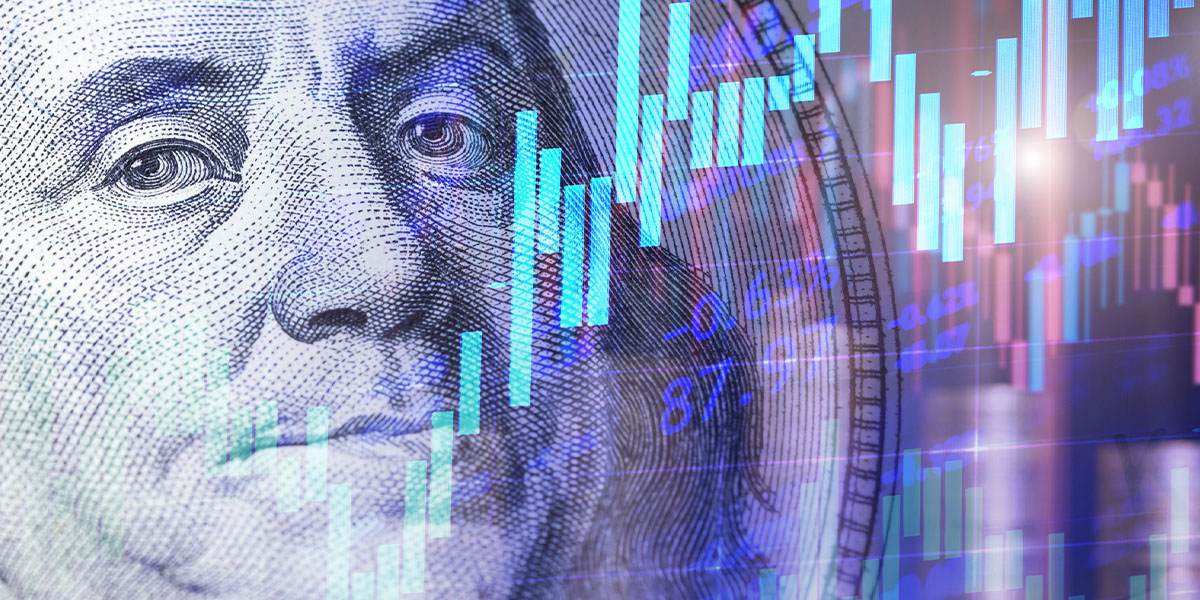For those of you who would prefer to listen:
Price action picked up its choppiness this week. Both stock and bond prices fell. Higher interest rates are finally mattering. It sure has taken longer than we anticipated. The 0% interest rate environment from the last decade and a half has completely come unwound. It’s a healthier place for the Market to get to. But the process of recalibration has been beyond bumpy. The correction began in 2022. It paused for much 2023. September made it clear, it’s back.
This week, the Federal Reserve decided to hold the overnight rate near 5.5%, a 22-year high. That was a virtual certainty. It’s the result of 11 rate hikes, which began in the Spring of 2022, putting an end to 0% interest rates. Even Japan, which led the negative interest rate brigade a decade ago, has a positive rate at 1%.
It wasn’t the rate pause that spooked the Market. That was expected. The thing that sent stocks lower and bond yields higher was the Fed’s guidance for 2 rate cuts in 2024. The Market had been pricing in 4. The median projection for the Federal Funds rate at the end of the year was 5.6%, implying one more hike. That is identical to the projection back in June. The Fed also increased their forecasts for the overnight rate at the end of 2024 to be 5.1%, compared with the previous 4.6%. The median projection for the end of 2025 rose to 3.9% from 3.4%. That’s the missing ½% the Market had been pricing in. It went away. Fewer rate cuts are now seen in 2024. The Market didn’t like that. Stocks fell on that news.
The Yield Curve remains inverted, something that occurred early in 2022. That happens when the short-term rate is higher than the long-term rate. It’s backwards. It’s been that way for a while. In fact, this is the second longest duration of an inversion on record, second only to the 1980s. Inverted yield curves have long been a signal for recession ahead. It’s been pretty accurate. The problem is it has been a very poor indicator in timing. The Yield Curve can be inverted for months and even years. The 2-Year Treasury yield hit 5.2% this week, while the 10-Year hit 4.5%. These are both levels not seen since 2006, before the Financial Crisis. These benchmark rates drive other lending products. A 30-Year mortgage hit 7.5% this week. That is the most expensive since Y2K.
Interest rates are the price of money. The price of money has gotten expensive. It happened fast. Asset prices generally fall when rates rise. It makes it more expensive to buy stuff. Higher rates are a tool, a cooling agent if you will, for overheated asset values. They tend to pop bubbles. That was the case last year. It’s never immediate, often taking time to work through the system. Things started looking a little bubblicious again over the Summer as the AI theme captivated the Stock Market. That bubble got pricked too. To be sure, Artificial Intelligence is real and a complete and total game changer for the future of our daily lives. But it seemed pretty clear that many of those investments got ahead of themselves. People got pretty excited and bid those stocks skyward. They’ve come back to Earth. Corrections address the excesses.
America has a debt problem. The Federal debt has now topped $33 Trillion for the first time. It’s happening at a particularly tough time. Congress is fighting over spending and threatening another government shutdown. Unless lawmakers can agree to pass a dozen appropriations bills by September 30th, or agree to a short-term continuing resolution to fund the government, the United States will face another Federal shutdown. It’s not a good look. It reflects poorly both here and abroad. And unfortunately for all of us, there’s not much of anything that Congress can agree upon these days.
Spending is a serious problem. We continue to spend more than we make. The national deficit for the first 11 months of this fiscal year was $1.5 Trillion. That is a 61% increase from the same period a year ago. Total public household debt hit a record $17 Trillion in Q2. Credit card debt, the most expensive kind, is now over $1 Trillion for the first time. America’s debt-to-GDP ratio is roughly 120%. It’s not a good trend and there are no signs of slowing.
Here’s the deal: The spike in interest rates over the past year and a half has made the cost of servicing the national debt way more expensive. That presents significant risks to the fiscal and economic outlook. Extreme partisanship has also left both parties pointing fingers and kicking this can further down the road.
House Speaker McCarthy continues to face stiff opposition to his proposal for a short-term spending solution from hardliners within his own party. According to our Washington sources, “The hardliners — and there’s a big split among conservatives here — refuse to allow House GOP leaders to pass a stopgap funding package to avoid shutdown. Kevin McCarthy’s inner circle has become convinced that conservative House Republicans are looking to provoke a shutdown in order to push him out of the speakership.” That’s a serious problem.
We mustn’t forget, Kevin McCarthy’s ability to lead a very fractured and narrow 5-seat Republican majority was tested immediately. It took an unprecedented 15 votes to win the Speaker job at the start of the year. McCarthy did exceed expectations when he was able to unite House Republicans to pass a partisan debt limit bill that forced President Biden to negotiate with him. The success didn’t last. The deal that McCarthy negotiated with the President has not aged well within the far-right House Freedom Caucus. Many are the members trying to impeach the President.
Our sources believe Speaker McCarthy is trying to convince House Republicans to replay the debt limit playbook by unifying behind a partisan proposal that has no chance of passing the Democrat-controlled Senate, but one that he hopes will provide him with more leverage in negotiations with the White House and the Senate.
What makes this go around more tricky, unlike the debt limit deal, Senate Minority Leader Mitch McConnell is aligned with Democrats in supporting the McCarthy-Biden spending levels in the debt ceiling deal. But just this week, Senator John Cornyn from Texas and Senator John Thune from South Dakota both voiced support for the House Speaker to figure this out. This is important because Cornyn and Thune constitute two of “Three Johns” vying to replace the ailing McConnell as the Republican Senate Leader. The fact that they appear to be backing McCarthy suggests McConnell may no longer be calling the shots, or at least a change in strategy. Regardless, according to our Washington sources, it increases the odds of a government shutdown.
So what would a government shutdown on October 1st look like, you might ask? Temporary funding is often enacted at the previous year’s level. That would mean no growth to government program spending until appropriations bills are passed. In a government shutdown, non-essential government personnel are furloughed, and non-essential programs are placed on pause.
Essential services would continue. The military unquestionably continues to safeguard the nation, even though they won’t be paid. Treasury auctions would proceed as scheduled. Social Security checks will still come. The US Mail would still be delivered. Air traffic controllers and TSA representatives would not be paid, but they would continue to work, allowing commercial flights to continue regular way. That is, if the workers show up. For perspective, the previous government shutdown in 2018 that lasted 34 days, air traffic controllers showed up for work and only threatened to stop as the weeks continued, which helped put an end to the standoff.
Non-essential services would be disrupted. National parks would close. Passport and visa applications would not be processed while the government is shut down. Something that could impact the Market: Economic reports are deemed non-essential. So, there would be no employment reports, inflation data, or other economic reports issued until the government reopens. The lack of economic data could potentially complicate the Fed’s job, which has indicated it is data-dependent. It might not see much of the data ahead of its next meeting on November 1st.
The Market has been taking the prospects of a government shutdown very much in stride. Despite the frustrating and disturbing headlines, the Market has been pretty calm on the subject. Any shutdown would be widely expected to be short in duration, with a deal eventually reached. More important, the risks are fundamentally different than with the debt crisis earlier this year, which was far more dire.
The clear issues for the Market are the Fed, interest rates, inflation, earnings and the economic slowdown with a growing potential for recession in 2024. So, the big questions are: Have the 5%+ in interest rate hikes delivered since March 2022 already worked their way through the Economy? Will things hold up if those levels are held through 2024? What about other curveballs like higher energy costs, student loan repayments, labor strikes or a government shutdown? The Market is trying to figure all of it out real time. It’s our sense that the aggressive rate hikes are just now finally making the impact and slowing down economic activity and asset prices. It has certainly taken longer than we anticipated.
The correction continues. Frankly, we were surprised at how strong the Stock Market had been in 2023, having maintained a more defensive posture, which served us so well in 2022. Stocks are for sale again and the price declines are picking up speed. September tends to do that. The S&P 500 ended its streak of 100 days without falling more than 1.5%. It happened Thursday. It was well overdue. That was the longest stretch since 2018.
We’re staying on the defensive for the time-being. It looks like Tech has more to go to correct. The Bond Market has attracted our attention for much of the year, finding comfort and safety in those 5% yields at the front-end of the curve. We’ll keep hanging out there for a while longer as this correction runs its course. We’re long-term investors equipped to deal with short-term issues. We’re doing just that and hanging in just fine.
Have a nice weekend. We’ll be back, dark and early on Monday.
Mike







